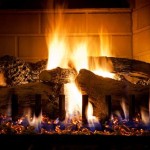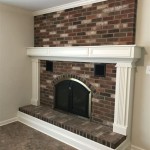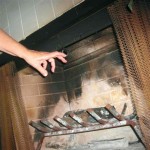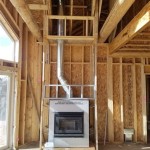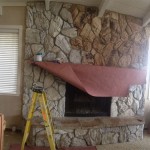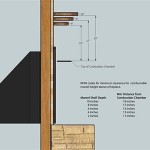Fireplace Wood Stove Inserts: A Comprehensive Guide
Fireplace wood stove inserts are heating appliances designed to be installed within existing masonry fireplaces. They offer a more efficient and controllable heating solution compared to traditional open fireplaces. This article provides a detailed examination of fireplace wood stove inserts, covering their benefits, types, installation considerations, maintenance, and important safety information.
Enhanced Heating Efficiency
Traditional open fireplaces are notoriously inefficient, with a significant portion of the heat generated escaping up the chimney. The open design allows for substantial airflow, drawing warm air out of the room and replacing it with cold air from outside. This creates a negative pressure effect, leading to drafts and overall lower heating efficiency. Fireplace wood stove inserts, on the other hand, are designed to maximize heat output and minimize heat loss.
The closed combustion chamber of an insert allows for more complete combustion of the wood, extracting more heat energy. Baffles and secondary combustion systems within the insert further enhance efficiency by burning off smoke and gases that would otherwise be lost up the chimney. This results in a cleaner burn with reduced emissions and higher heat output. Many modern inserts also incorporate fans to circulate the heated air into the room, distributing warmth more effectively and evenly. The increased efficiency translates to lower fuel consumption, reduced heating costs, and a smaller environmental impact.
The efficiency of a wood stove insert is typically measured by its heating efficiency rating, expressed as a percentage. Higher percentages indicate greater efficiency. Consumers should review these ratings when selecting an insert to ensure it meets their heating needs and aligns with environmental regulations. Factors like the size of the space to be heated and the climate in which the insert is used will also influence the overall heating performance.
Types of Fireplace Wood Stove Inserts
Fireplace wood stove inserts are available in various types, each with distinct features and benefits. Understanding these differences is crucial for selecting the appropriate insert for a specific fireplace and heating requirements.
Steel Inserts: Steel inserts are often the most affordable option. Steel conducts heat quickly, allowing for rapid heat-up times. However, steel can also cool down relatively quickly once the fire diminishes. Thicker steel gauges offer better heat retention. Steel inserts are generally lighter than cast iron inserts, which can simplify installation.
Cast Iron Inserts: Cast iron inserts are known for their excellent heat retention capabilities. Cast iron absorbs heat slowly but then radiates it steadily over an extended period. This provides a more consistent and comfortable heat output. Cast iron inserts are typically heavier and more durable than steel inserts, but they can also be more expensive. The intricate designs often found on cast iron inserts can also enhance their aesthetic appeal.
Catalytic Inserts: Catalytic inserts utilize a catalytic combustor to reduce emissions and increase efficiency. The combustor is a coated honeycomb structure that burns off smoke and gases at a lower temperature. This results in a cleaner burn with reduced particulate matter emissions. Catalytic inserts often require more maintenance than non-catalytic inserts, as the combustor may need to be replaced periodically.
Non-Catalytic Inserts: Non-catalytic inserts rely on advanced firebox designs and secondary combustion systems to achieve clean burning and high efficiency. These inserts typically feature baffles and air tubes that introduce preheated air into the firebox, promoting complete combustion. Non-catalytic inserts are generally easier to maintain than catalytic inserts and often have a longer lifespan.
Hybrid Inserts: Some inserts combine features of both catalytic and non-catalytic technologies. These hybrid models aim to provide the best of both worlds – high efficiency, low emissions, and relatively simple maintenance.
Installation and Safety Considerations
Proper installation and adherence to safety guidelines are paramount for the safe and efficient operation of a fireplace wood stove insert. Incorrect installation can lead to fire hazards, carbon monoxide poisoning, and other serious risks.
Professional Installation: It is strongly recommended to have a qualified professional install the insert. A professional installer has the necessary expertise to ensure that the insert is properly connected to the chimney, that adequate clearances are maintained, and that all safety regulations are met. Professional installation also often includes an inspection of the existing chimney to ensure it is in good condition and suitable for use with the insert.
Chimney Liner: A chimney liner is essential for safely venting the exhaust gases from the insert. The liner protects the masonry chimney from the corrosive effects of the flue gases and prevents carbon monoxide from leaking into the home. The liner must be properly sized and installed according to the insert manufacturer's instructions and local building codes. Stainless steel liners are typically recommended due to their durability and resistance to corrosion.
Clearances: Maintaining proper clearances around the insert is crucial to prevent overheating and fire hazards. The manufacturer's instructions will specify the required clearances from combustible materials, such as walls, floors, and furniture. Heat shields may be necessary to reduce clearances and protect nearby surfaces. Ensure that the insert is placed on a non-combustible hearth extension that meets the minimum size requirements specified in the building codes.
Carbon Monoxide Detectors: Carbon monoxide (CO) is a colorless, odorless gas that can be deadly. It is essential to install carbon monoxide detectors on every level of the home, particularly near sleeping areas. Test the detectors regularly to ensure they are functioning properly. If a CO detector alarms, immediately evacuate the home and call emergency services.
Wood Storage: Store firewood away from the insert and other potential ignition sources. Proper wood storage helps to prevent the spread of fire. Stack the wood in a dry, well-ventilated area to allow it to season properly. Seasoned wood burns more efficiently and produces less smoke.
Regular Inspections and Maintenance: Schedule regular inspections and maintenance of the insert and chimney to ensure they are in good working order. A qualified chimney sweep can inspect the chimney for creosote buildup, blockages, and structural damage. Creosote is a highly flammable substance that can accumulate in the chimney and cause a chimney fire. The chimney should be cleaned regularly to remove creosote buildup.
Operating Guidelines: Follow the manufacturer's operating guidelines for the insert. Avoid overloading the firebox with wood, as this can lead to overheating and excessive smoke production. Use only seasoned wood and avoid burning treated wood, painted wood, or other materials that can release harmful chemicals into the air.
Ventilation: Ensure adequate ventilation in the room where the insert is located. This helps to prevent the buildup of carbon monoxide and other pollutants. Open a window slightly to provide fresh air circulation.
Ash Removal: Remove ashes from the firebox regularly to maintain efficient combustion. Allow the ashes to cool completely before disposing of them in a metal container with a tight-fitting lid. Keep the container away from combustible materials.
Sizing and Choosing the Right Insert
Selecting the appropriate size wood stove insert for a particular space is a critical factor in achieving optimal heating performance. An undersized insert will struggle to adequately heat the space, while an oversized insert can lead to overheating and wasted fuel. Accurate sizing ensures comfortable and efficient heating.
Square Footage: The square footage of the area to be heated is a primary consideration when sizing an insert. Manufacturers typically provide recommendations for the maximum square footage that a particular insert can effectively heat. These recommendations are based on factors such as insulation levels, ceiling height, and climate.
Climate: The climate in which the insert will be used also influences the appropriate size. Homes in colder climates will generally require larger inserts than homes in milder climates to maintain a comfortable temperature. Consider the average winter temperatures and the severity of the winters in your region when selecting an insert.
Insulation: The insulation levels in the home play a significant role in heat loss. Homes with poor insulation will require larger inserts to compensate for the increased heat loss. Ensure that the home is adequately insulated before selecting an insert to maximize its heating effectiveness.
BTU Output: The British Thermal Unit (BTU) output of the insert is a measure of its heating capacity. Higher BTU ratings indicate greater heat output. Compare the BTU ratings of different inserts and select one that is appropriate for the size and insulation levels of the space to be heated.
Firebox Size: The firebox size of the insert determines the maximum size and amount of wood that can be loaded at one time. Larger fireboxes allow for longer burn times and reduced refueling frequency. Consider the desired burn time and refueling convenience when selecting an insert with an appropriate firebox size.
Aesthetics: While heating performance is the primary consideration, the aesthetics of the insert should also be taken into account. Inserts are available in various styles and finishes to complement the décor of the home. Choose an insert that is visually appealing and fits seamlessly into the existing fireplace and room design.
Budget: The cost of wood stove inserts can vary significantly depending on the type, size, features, and brand. Establish a budget before shopping for an insert and compare prices from different retailers. Consider the long-term cost savings associated with increased heating efficiency when making your purchasing decision.
Local Regulations: Check local building codes and regulations before installing a wood stove insert. Some jurisdictions may have restrictions on the type of inserts that can be installed or require permits for installation. Ensure that the selected insert complies with all applicable regulations.
By carefully considering these factors, homeowners can select a fireplace wood stove insert that provides optimal heating performance, enhances the aesthetics of their home, and complies with all safety regulations.

Quadra Fire Expedition I Wood Insert Fireside Hearth Home

Wood Burning Fireplace Inserts Insert Installation

Why A Wood Burning Fireplace Insert Bethesda Md Service

Ventis Hei240 Wood Burning Insert Rockford Chimney

T25i Timberwolf Wood Fireplace Insert Hearth Stove Patio

Wood Inserts We Love Fire
Wood Stove Inserts In Our Fireplace Showroom

Osburn Matrix 2700 Wood Insert

Nova Wood Burning Stove Insert Ca Mf Fire

Should I Use A Fireplace Insert Or Wood Stove To Heat Up My Home
Related Posts


